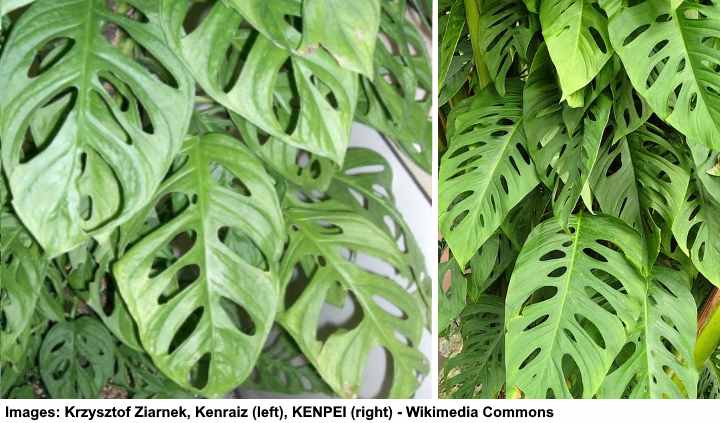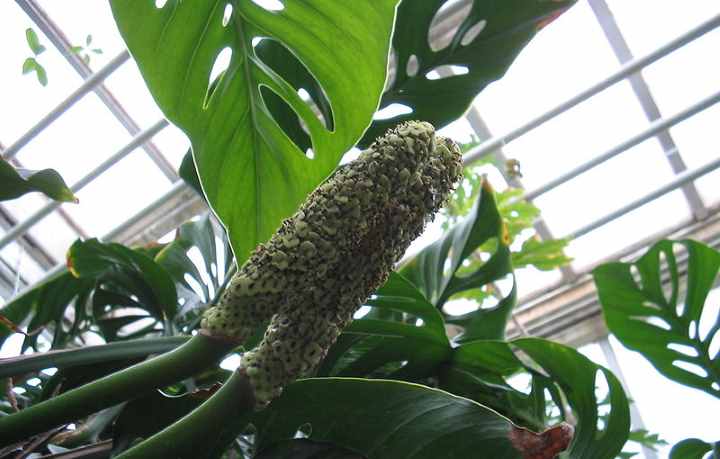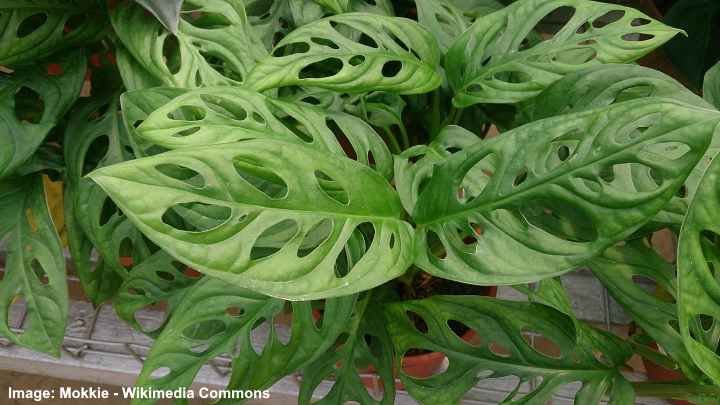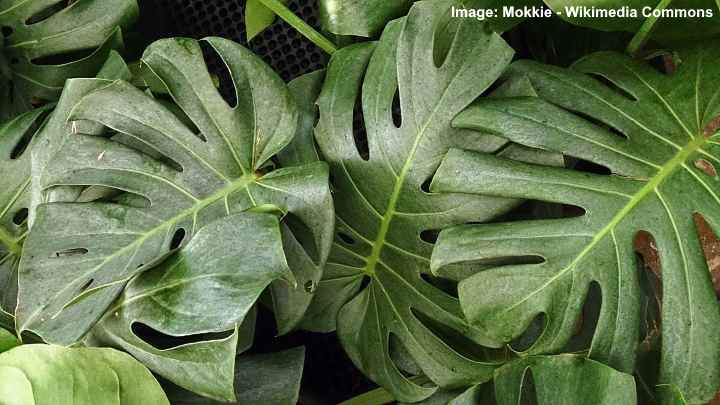Monstera Adansonii Care: How to Grow Swiss Cheese Plant

Monstera Adansonii is a type of tropical climbing vine that is a popular indoor houseplant. Also called a Swiss cheese vine, Five-Holes Plant, or Monkey Mask plant, the Monstera adansonii has large ovate leaves with oval holes in them. Unlike the Monstera deliciosa, the circular holes don’t develop in to split leaves. These tropical houseplants are easy to care for at home.
How to care for Monstera adansonii: Plant in a suitable container with rich soil that drains well and water when the potting mix is partly dry. The Swiss cheese houseplants enjoy indoor locations that are bright with indirect sunlight and temperatures between 70°F and 75°F (21°C – 24°C). Fertilize monthly and mist your Swiss cheese vine weekly for best results.
Monstera adansonii is a medium-sized houseplant that is slow-growing with few care requirements. Its small size means that it is easier to care for than the large Monstera deliciosa (split-leaf philodendron). The Monkey Face plant grows well as a climbing tropical plant when supported or in a hanging basket with fascinating trailing “holey” foliage.
In this article, you will learn all you need to know on how to care for your ‘little Swiss Monstera, or ’Monstera adansonii’.
What is Monstera Adansonii (Swiss Cheese Plant)?

Monstera adansonii in its natural habitat and indoors as a houseplant
Monstera adansonii belongs to a group of tropical flowering plants in the family Araceae.
The climbing vines are native to Central and Southern America. The trailing stems cover rainforest floors or climb up trees. Like all Monstera plants, the adansonii variety has aerial roots that cling to surfaces and also absorb nutrients and moisture from the air. These aerial roots make the Swiss climbing vines a type of epiphytic plant.
Monstera adansonii leaves are ovate with many circular holes—hence the name ‘Five-Holes Plant.’ Leaves grow to between 8” and 16” (21 – 42 cm) long and around 5” (12 cm) wide. In their native habitat, the long vines can reach up to 65 ft. (20 m) long. When growing in containers indoors, proper pruning and support can help to control growth.

In their native environment, Monstera adansonii produces yellowish-white flowers. These arum-flowers have a large petal-like spadix that surrounds a white spathe. The flowers become edible fruits that have a pineapple-banana taste. These flowers are similar to calla lily flowers—they’re from the same family as Monstera plants.

Monstera adansonii with fruit
How to Care for Monstera Adansonii (Swiss Cheese Plant)
Caring for Monstera adansonii as a houseplant is relatively straightforward. The most important care tips for Monkey Masks is to grow them in bright locations and get the watering right.
Let’s look in more detail at how to help your M. adansonii thrive indoors.
Monstera Adansonii Light Requirements
Swiss cheese vines grow in tropical rainforests and need bright, indirect sunlight. The best place for a Monstera adansonii in near an east- or west-facing window. These locations ensure the plant gets a few hours of daily sunshine, but not too much direct light. In a south-facing room, keep it well away from the window.
Although Monstera plants such as the adansonii prefer bright locations, they also grow well in dimly-lit rooms. These are excellent low-light plants for offices, north-facing rooms, or places with little natural light. The only thing you may notice is that holes may not develop in the leaves when there’s not enough light.
You can also grow your Monstera adansonii as a trailing hanging basket outdoors. The growing zones for Monstera plants are 10 and 11. If you live in temperate climates, then you can transfer a potted Monstera plant outdoors in summer. The minimum temperature for these green leafy houseplants is 50°F (10°C). So, bring them back into your home when the temperatures drop in fall.
How to Water a Swiss Cheese Vine Plant
For a Swiss cheese vine to thrive, you need to water them correctly. Only water when the top 1” or 2” (2.5 – 5 cm) of the soil is completely dry. To water, pour enough water in the container until the water completely drains from the bottom. Wait until the soil is partly dry before repeating.
The most common Monstera diseases—root rot, yellow leaves, brown leaf spots—are generally attributed to watering issues. Houseplants that sit in damp, soggy potting soil develop all sorts of problems. So, always allow the top part of the potting medium to dry before watering. It is best to err on the side of caution and water your Monstera less rather than more.
Four watering tips for Monstera plants:
- Make sure that your pot or container has plenty of drainage holes to prevent excessive soil dampness.
- Use well-draining soil that doesn’t hold too much moisture.
- Deep watering helps to nourish the roots to promote healthy plant growth.
- Only water your plant when the soil has partly dried out.
Monstera Adansonii Soil
This houseplant grows best in fertile potting soil that allows water to drain well. The best potting mix for Monstera adansonii should contain a mixture of potting soil, peat, and perlite. Plenty of organic matter helps mimic the natural environment where Monstera plants grow in nature.
One way to check if your soil is right for your houseplant is to see what happens when you water it. If water tends to gather or pool on the top, then your potting soil is too heavy. Work in some organic matter and perlite to lighten the soil and improve drainage. Organic matter helps retain just the right amount of moisture without the mix getting too damp.
Best Temperature for Monstera Adansonii (Money Mask Plant)
Because they are tropical rainforest plants, Monkey Masks or Swiss cheese plants thrive in average room temperatures. The best temperatures are between 70°F and 75°F (21°C – 24°C). Keep away from drafts or radiators, especially in winter. Monstera plants don’t tolerate temperatures under 55°F (12°C).
It can be challenging to care for Monstera adansonii indoors during hot summers and cold winters. Air-conditioning and household heating can cause sudden temperature changes. Also, heating or cooling your home tends to dry the air. So, to keep your indoor plant thriving in all seasons, and pay attention to the right humidity.
Humidity Requirements to Grow Monstera Adansonii (Five-Holes Plant)
It’s essential to give your Monkey Mask plant plenty of humidity, just like they get in the jungle. To keep humidity levels high, you can mist the leaves regularly, use a room humidifier, or set your Swiss cheese vine on a pebble humidifying tray.
Misting is one of the easier ways to care for your “Swiss cheese philodendron.” Fill a spray bottle with water and spritz the leaves every three or four days. Every so often, check the soil for dryness to know if you need to water it.
To use a pebble tray to increase humidity levels, put some decorative pebbles in a shallow dish. Fill with water until half-way up the stones. Place the Monstera pot on the pebbles, making sure the pot doesn’t sit in the water. Evaporation helps humidify the leaves. Top the tray up with water when necessary.
Apart from using a humidifier, you can also place your Monstera pot plant in a humid environment. The best rooms in your house are your bathroom—if there is enough light—and your kitchen.
Fertilizer to Feed a Swiss Cheese Plant
You will need to feed your Swiss cheese vine plant once a month during the growing seasons—spring and summer. Use a water-soluble general houseplant fertilizer. Regular monthly feeding helps keep the foliage healthy and encourages proper growth. Don’t feed during the fall and winter.
Every so often, it’s a good idea to flush the soil to prevent a buildup of mineral salts. Plant pot soil flushing is best done every three months or so before feeding. Slowly run water through the soil and let it drain out the bottom. As a general rule, use about four times the amount of water as soil and let all the water drain.
As a word of caution: remember that fresh potting soil has plenty of nutrients. So, you’ll not need to feed your Monstera for a few months after repotting.
Repotting Monstera Adansonii Indoor Plant
Your Monstera plant will benefit from repotting every two or three years. Always choose a deep pot that is appropriate to the size of your plant. Signs you need to repot your Monstera are roots growing out the drainage holes, stunted growth, or inadequate drainage.
If you want to encourage growth, choose a larger container. If you’re going to keep the plant at the same size but need to refresh the potting soil, repot in the same container.
Here is a short guide to repotting your Monstera adansonii Swiss cheese vine:
- Carefully remove the plant from its existing container.
- Remove as much soil as you can from the roots and check for signs of root rot or damage.
- Trim off any damaged or diseased roots. If replanting in the same container, prune the roots back to prevent the plant from becoming rootbound.
- Put some fresh, moist potting soil in the new container, making sure the plant is planted at the same height as before.
- Fill remaining space with the potting soil, peat, perlite mix and gently press around the stems for support.
Pruning Monstera Adansonii
Prune your Monstera Swiss cheese plant in spring if you need to control its growth. Under the right conditions, these climbing vines are vigorous growers. Prune the top growth and remove any dead, yellow, or damaged leaves. Cutting healthy stems as close as possible to the main stem also gives you cuttings for propagation.
Regular pruning helps prevent your Monstera from becoming unkempt and leggy. It’s not necessary to prune the air roots. However, you can do so if necessary. Or, you can tidy up the plant’s appearance by putting the aerial roots in the soil.
Propagating Monstera Adansonii
Using stem cuttings is the best way to propagate Monkey Mask plants. Prune off a healthy stem that has at least two nodes. Place the stem cutting in water until roots appear—this can take a few weeks. Plant in a pot with fresh Monstera potting mix.
Propagated Monkey Mask plants make excellent gifts because they are low-maintenance and have unusual foliage.
Is Monstera Adansonii (Swiss Cheese Plant) Toxic?
Monstera plants are toxic to dogs, cats, and other pets. Ingesting the leaves or other parts of the plants can cause vomiting, skin irritation, swelling, and drooling. (1)
Common Monstera Adansonii Diseases
Monstera species of plants tend to be quite hardy and resistant to disease. The most common diseases to afflict Monstera plants are related to over-watering. You can avoid these diseases by only watering your tropical plants when the soil is dry and making sure that the potting medium drains well.
Pests that Affect Monstera Adansonii Growth
Pests aren’t usually a problem with Monstera adansonii plants. Sometimes, you may have spider mites—look for thin webs around the leaves—or mealybugs—look for white fluff at the stem joints. If left alone, these pest infestations can eventually kill your prized Monstera plants, not to mention infest other houseplants.
Use a natural neem oil solution or insecticidal soap to get rid of houseplant bugs naturally. Read this article to find out more.
Common Question About Growing Monstera Adansonii Plant
Although growing a Monstera adansonii is relatively straightforward, there are a few more things to know about caring for this tropical houseplant.
Here are the answers to frequently asked questions about this Swiss cheese plant.
What is the difference between Monstera obliqua and Monstera adansonii?

In the picture: monstera obliqua
Monstera obliqua is a rare type of monstera plant, and it has papery-thin leaves with huge holes. Looking at pictures of Monstera obliqua leaves, there seem to be more holes than leaf—up to 90% of the leaf consists of holes. Compared to Monstera adansonii, the obliqua species has smaller leaves that are much thinner.
Some people refer to the Monstera adansonii as Philodendron or Monstera obliqua. However, a genuine obliqua plant’s leaf is mostly holes and less attractive.
How do Monstera plants get holes?
The unusual feature of all Swiss cheese plants is the holes or splits in the leaves. Scientists are not sure why the glossy green leaves develop holes. Some botanists theorize that this climbing vine has split leaf blades to increase the leaf area to capture more sunlight and moisture.
Why doesn’t my Monstera have holes?
Young, immature Monstera plants don’t have leaves with holes or splits. However, as the tree matures, slits and holes develop among the leaves.
If your Monstera doesn’t develop slits, it could be due to low light. Even though these tropical plants survive in dim light, they need bright, indirect light for the leaves to split. So, try moving your plant to a brighter location.
Why are my Monstera adansonii leaves turning brown?
Brown or yellowing leaves on a Monstera plant are usually due to watering issues—over-watering or damp, soggy soil. Check the potting soil to see if it’s wet to touch. If so, hold off watering until the soil mostly dries out. If that doesn’t help, you may have to repot your Swiss cheese vine to revive it.
My Swiss cheese plant leaves are drooping, what should I do?
If you notice that your Monstera looks like it’s wilting and dying, check the soil. More often than not, drooping leaves are due to a lack of moisture. Thoroughly water your plant to give the roots a deep watering and then mist the leaves.
Other Types of Monstera Plants
Each of the 50 different species of Monstera plants has its own unique characteristics. Let’s look at a few of the more popular plants and also some rare plants.
Rare Monstera adansonii variegated plant
Variegated Monstera plants are extremely rare, and the Monstera adansonii variegata is no exception. The split glossy green leaves have brilliant white variegation to create unique and stunning foliage.
Monstera pinnatipartita
Long thick stems and glossy green, ovate split leaves are the main features of the Monstera pinnatipartita.
Monstera obliqua
This species of Monstera has some of the rarest and unique foliage you will find on any plant. The papery-thin leaves look disheveled due to the number of large holes. On most Monstera obliqua species, the leaf surface only makes up ten percent of the leaf surface.
Monstera siltepecana
Monstera siltepecana has small silvery-green leaves and will eventually develop slits as it matures. These tropical climbing plants have smaller leaves than the adansonii or deliciosa Monstera species.
Monstera deliciosa

One of the most popular Monstera plants is the Monstera deliciosa. The classic Swiss cheese plant has large green leaves with deep, wide splits in them. This climbing vine house plant can grow up to 8 ft. (2.4 m) tall indoors and has mature leaves that can grow to nearly 3 ft. (90 cm) long.
Related articles:
- Drought Tolerant Plants That Don’t Need Water
- Unique, Cool, and Unusual Houseplants You Need to Grow
- The Best Closed Terrarium Plants (with Pictures)
